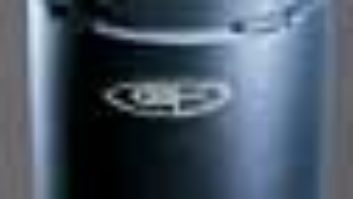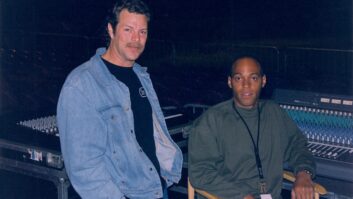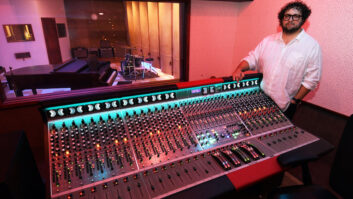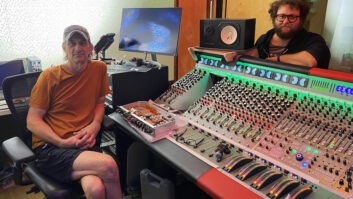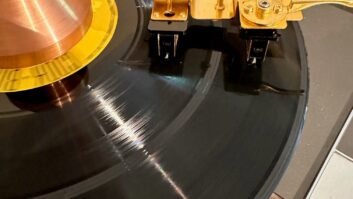There is nothing quite like the sound of the well-recorded musical
interplay of an ensemble of acoustic instruments. Long before
“unplugged” became part of the pop culture lexicon,
Nashville was mastering the art of recording the great acoustic country
and bluegrass groups that rolled through town. Capturing the unique
characteristics of each instrument and understanding how to present the
chemistry of the overall band sound requires skill and sensitivity to
the special dynamics of the players.
Mix rounded up a handful of Music City’s finest players
and producer/engineers to discuss their thoughts on how to capture the
sparks on tape. Thanks to the participants and also to Ellen Pryor and
Elliot Scheiner for their support.
CHUCK AINLAY
If you were searching for the personification of the consummate
engineer with a really great vibe, it would be Chuck Ainlay.
Ainlay’s credits, which include heavyweights like Mark Knopfler
(solo and with Dire Straits), Trisha Yearwood, Vince Gill, Steve Earle,
Lyle Lovett, Wynonna and George Strait, are enough to give most people
an attitude. Ainlay, however, is absolutely unpretentious, easygoing
and approachable. In fact, he could just as easily get enthused about
going out on his boat as discussing the new surround sound mixing room
he and Denny Purcell are setting up in Nashville. Ainlay is currently
co-producing with Mark Knopfler on Knopfler’s next solo effort,
among many other projects.
“For Vince Gill’s previous album, High Lonesome
Sound, we used Alison Krauss’ band for the title cut. They
played on the country version with drums and everything, and we also
did another version, which is bluegrass. Both versions are on the
album. If you’re talking about bluegrass, the players really like
to hear and watch each other. That’s how they perform live. So
when we did the bluegrass version, I basically used baffles laid out
like a spoked wheel, where the baffles were radiating out from the
center like the spokes. This created compartments where each person
could look toward each other in the center, and the mics would be back
sort of closer to the center pointing toward each player. That way, you
could use the directional characteristics of the cardioid microphones
to reject the other instruments of the other players at other areas in
the other spokes. Cardioid is generally what I use. I rarely ever use
omni microphones. Also, you don’t want to get the mics too close
to any sort of wall, because that would change the character of the
microphone, too. So they’re not right into the point of the pie,
so to speak. I used baffles because I wanted a real clean, tight sound
with not a lot of ambience from the room.
“Generally, for tracking the acoustic guitar, I’ll
usually use one mic sort of near the 12th fret, out maybe six inches
from the guitar. Then I’ll have another mic, generally shoulder
height and out maybe two feet from the guitar, probably kind of above
the bridge or the general vicinity. If I then decide to double the
acoustic guitar, I usually forego the far mic because it is just too
big. The doubling already gives you that extra warmth.
“I love a KM56 or KM54 on an acoustic. That is usually my
choice of a close mic. They have a nice top end, and the bottom end is
rolled off pretty well on them. I will also use a Neumann KM84. For the
second mic, the one that may be located about shoulder height, I would
start with maybe a U67. U67s are great on acoustics, if you’re
going for that bashing acoustic guitar sound. If you’re using a
Gibson acoustic that is being played hard, you can take a U67 and mike
it farther away from the guitar, just straight out from the hole of the
guitar, and get a great sound. Naturally, it all depends on what the
player is doing.
“On Vince Gill’s acoustic, I will use an AKG 452 because
the isolation is better. The polar pattern is tighter, so I can get
away with using that microphone and still use the tracking acoustics.
The problem with those microphones on acoustics is that sometimes they
can be too brittle-sounding, so you add some warmth to them in the
midrange area. Yet you will need to roll out on the bottom, because
when you have a vocalist, you have to mike close.
“The quality of the guitar also makes a lot of difference. For
just pure strumming, a lot of people have gone to kind of cheap guitars
like Takamines, because they don’t have a lot of bottom end and a
real rich character to them. What you’re really looking for is a
percussive strumming, rather than a filled-out acoustic sound.
“For fiddle, I really like the [AKG} C-12; it works great.
Mark O’Connor, who is one of the greatest fiddle players, always
carried a C-24 with him, which is the stereo version of the C-12. For
upright bass, I use two microphones. Usually there is one microphone
about a foot-and-a-half away from the double bass about bridge height,
and then the second mic is usually closer to the bass, maybe about
eight to ten inches looking at the left shoulder of the bass. That way
you get the percussive wood ‘plunk’ from the bass there.
You get your bottom end from down near the bridge. Sometimes, depending
on the bass, you have to get it closer to the F hole; though some
basses will have certain notes that really stick out if you get too
close to the F hole. I like to put the upright bass in a separate room,
because it’s not a very loud instrument. You still want to have
control, and you’re going to get leakage with it.
“For mandolin, I rarely mike with two mics; it’s just
too small of an instrument. But it all depends on the mandolin. Some
mandolins are richer and warmer than others. Generally the favorite
position is near the F hole. But getting too close to the F hole can be
too thick. If you’re looking for that ‘woody’ sound,
that is where it comes from.
“In general, I don’t think that there is anything all
that special that we do. I always like to point out that it comes from
the musicians and the music. I can’t tell you how many times
I’ve sat there and pulled up levels and it just sounded like
crap, and I’m tweaking knobs like crazy, trying to get it to
sound good. Then all of a sudden it sounds good, but it isn’t
because I tweaked the knobs like crazy. It’s because the
performance came together, and all of a sudden everybody was listening
to each other and playing tight. I think we are important people in not
ruining this and making it comfortable for the musicians, but it still
gets down to the players.”
JERRY DOUGLAS
Multi-instrumentalist/producer Jerry Douglas has produced dozens of
albums featuring acoustic ensembles and artists, including many for
Barry Poss’ North Carolina-based Sugar Hill record label.
Life magazine named Jerry one of the “Top Ten Best Country
Musicians of All Time,” and his Hop, Skip and Wobble
project (with Russ Barenberg and Edgar Meyer) made Guitar
Player’s Essential 100-CD collection list. Douglas has taken
home six Grammy Awards and six IBMA Dobro Player of the Year Awards.
His latest effort on Sugar Hill, Restless on the Farm, is
classic Douglas and well worth checking out.
“I like the live performance vibe and keeping everything as
organic as possible going down on tape. I always like first takes,
because that’s when all the energy is up and it’s the
scariest for everybody. I don’t erase anything. I don’t
punch into live tracks. I do adjacent tracks for instruments.
If we need to fix something, then great. But if there is a chance of
leaking, then we do another take or another edit possibly. This is
because you don’t want the chance of ‘ghosts,’ which
is something you get a lot in acoustic music. When you overdub, you run
the chance of still hearing the old part off of someone else’s
track. So it’s worth doing another take.
“When I’m working with a bluegrass act, like Del McCoury
for instance, whose band plays really dynamic bluegrass, I try to cut
live without much isolation and get some tight mics on everybody. I
like to sit them so everyone can hear and see each other and not be
completely dependent on headphones, but use them if they want to. We
often use these big foam baffles. It’s amazing how much isolation
you can get from one of those things. Then it becomes easier to replace
parts if something goes wrong.
“For picking out the mics in this kind of situation, I would
shy away from the bigger-diaphragm microphones. It’s a give and
take situation, because I love the old, big-diaphragm microphones for
when these instruments are isolated, because they capture the whole
sound of the instrument and not just a spot on the instrument.
“Bass and fiddle are kind of hard to track in the room. Fiddle
sometimes just takes off all over the room, and bass goes to the floor
and shows up in the strangest places. I try to isolate the fiddle out
of the room, like I would the vocal, too.”
MARK O’CONNOR
Nashville-based violinist Mark O’Connor has enjoyed a career that
has enabled him to follow his artistic muse from bluegrass to jazz/rock
fusion to more classically oriented undertakings. O’Connor has
recorded on projects like Will the Circle Be Unbroken #2,
Michael Brecker’s Grammy-winning album Don’t Try This at
Home, James Taylor’s Grammy-winning album Hourglass
and the Linda Ronstadt-Emmylou Harris-Dolly Parton Trio album.
As a solo artist, O’Connor has been nominated for seven Grammy
Awards, and won a Grammy for Best Country Instrumental Performance in
1992, for his album New Nashville Cats.
“When I’ve done bluegrass recordings, often people will
want the option to replace their solos and fix parts. Obviously,
it’s harder to do that in recording sessions where you’re
all playing in the same room. So when you do a democratic project, such
as [the group] Strength In Numbers, you want to leave the studio
knowing that you got what you wanted on tape. As a result, it made
sense to be isolated. So before we were done with the song, we got the
solo we wanted on there and we left and that was it. End of story.
“When I did the New Nashville Cats album, I put everybody in
the same room and said, ‘Trust me. I’m going to edit
together pieces from different takes.’ I’m a much greater
fan of editing, because [as the artist and producer] I can listen to
takes and find out the parts that have the best musical energy. If the
players got a really great solo section, but they completely botched
the last head, then I can have the freedom to experiment with editing
on a head from a different take, for instance.
“That kind of flexibility is actually more musical than
overdubbing. When you overdub, the other instruments are not playing
with you anymore. They are playing to another solo. So what the soloist
does on the overdub is not a complete musical communication. So even
though to a novice recording musician the editing might sound harsh in
approach, it is actually more musical, especially if the tempos are
fine and the energy and intensity match up. Then you can interchange
between takes. That is what I do on most of the things that I do. But
it depends on how complex the music is. I think the more complex the
music is, the more that you have to rely on editing.
“I’ve recorded most every solo performance I’ve
done for years, trying to get better and better with it. When I finally
realized that I was ready to record an album of these performances for
real, I picked one of my favorite places I’ve performed
solo—the old Shelton Hall in St. Louis, which was built in 1875.
I rented it out and got the great mics up—my old M49 Neumanns and
the old AKG C-24—and played in front of a live audience and
really did it right. For the Midnight on the Water recording, I used my
two old Neumann M49s in a stereo configuration. (The C-24, I’ve
found, is very good for close miking but not as much for accurate
ambient miking, whereas the M49s are almost like the human ear.) So
when I recorded my solo performance, I was actually achieving the
instrument sound and the sound of the hall all at one time with those
two mics. It really worked out.
“I also used the M49s on my Heroes album, so I could have
completely matched sounds between me and the other guest violinists.
The only difference that you were hearing between the violin sounds was
the actual player and the instrument and not the way it was recorded.
So each violin had one M49, each of which were evenly matched from the
same vintage year.
“Temperature changes the sound, and it changes the instrument.
My violin is very sensitive to humidity. My violin sounds better in a
warmer, humid climate. There are some violins that start to sound muddy
or like they are stuffed with socks in a warmer, humid climate, where
mine just sounds lush. Whereas when I get in too dry of a climate, it
sounds too trebly and scratchy and squeaky and it just drives me
crazy.
“In most studios, you don’t have to worry about the
humidity or lack of it too much. But in concert halls, it’s a
consideration. The biggest thing is to make sure that you can play your
best. If the climate is changing, but you’re in a place where you
feel you can play your best, then that more than compensates for the
problem.”
BIL VORNDICKM
Bil VornDick is one of Nashville’s finest engineers for
understanding what it takes to make great recordings that feature
acoustic instrumentation. Among his many credits are albums by Mark
O’Connor (including New Nashville Cats), Jerry Douglas (since the
early ’80s up to his latest record and Grammy-winner The Great
Dobro Sessions), Edgar Meyer, Béla Fleck, Doc Watson, James
Taylor, Alison Krauss (the Grammy-winning I’ve Got That Old
Feeling) and Del McCoury. He produced a new Ralph Stanley record
called Clinch Mountain Country, featuring an all-star cast
including Bob Dylan, George Jones, Vince Gill, Patty Loveless, Hal
Ketchum, Marty Stuart, Ricky Skaggs, Junior Brown and Diamond Rio, to
name just a few.
“I like to pick the musicians for the song, instead of just
working with a normal rhythm section. I like everybody to be going down
on tape at the same time. I want as many pieces of the puzzle working
with each other and playing off each other as possible, instead of
starting with a click track. I go for the overall feel of a take.
I’m a guy who still believes that people buy records because they
feel good.
“A good example: I had a Number One song on a group called
“III Time Out,” and the B string was out of tune. But the person who
was singing the lead vocal was playing the guitar at the same time.
That was his best performance, and we couldn’t re-do the guitar
because of the leakage. Quite a few people have come up to me and said,
‘The B string was out of tune.’ I would say, ‘Yeah,
we cut it quite a few more times, but the feeling and emotion
wasn’t there.’ I went with the best-feeling performance,
which had the emotion within that helped sell the song. It still went
to the top of the charts. There are some people who would go re-do the
vocal and the guitar and do other things to deal with the B string on
the guitar.
“Currently, there is a successful acoustic artist, whose roots
were in bluegrass, cutting tracks with a click and then going back and
replacing everything. As a result, you’ve got all of the nuances
that originally went on with the little inner licks and dynamics of the
song disappearing in order to be precise.
“Most of the albums that I’ve done that have won the
Grammys are all albums recorded on budgets between $10,000 and $25,000.
These are not quarter-of-a-million-dollar albums. Alison Krauss’
first Grammy-winning record cost, I think, $12,500.
“I mike everything in stereo normally, so that within those
two mics I have a depth perspective on each instrument. I’m a
pretty hardcore analog guy. You get the whole waveform in analog, and
in digital there are still quite a few overtones that the sampling
rates are not catching. I can still hear them, but a lot of people
don’t give a damn. I normally cut at 30 ips with no noise
reduction at plus 9. If I can get into a facility that has SR, I like
to cut at 15 ips with SR. Digital may be cheaper, but analog is still
the art form for me.”
